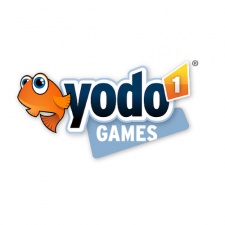China’s Android app stores seem like mysteries to many game developers and marketers.
Here, we unveil the "secrets" behind distributing games in China. We’ll also show you how Yodo1 can help you overcome common difficulties and simplify your entry to the world’s largest market for mobile games.
The plethora of Android app stores in China is different from Google Play and Apple App stores. Each store requires specific attributes and standards for a game to be accepted, including different image dimensions and formats, as well as the integration of multiple SDKs.
Which Chinese App Stores are the biggest?
Of China’s more than 30 major app stores, the biggest in terms of monthly active users are:
- Tencent My App: present on every device; 26 per cent market share
- Huawei App Market: on Huawei devices only; 13 per cent market share
- OPPO Software Store: on OPPO devices only; 13 per cent market share
- 360 Mobile Assistant: does not allow pay-to-play downloads; 10 per cent market share
- Baidu Mobile Assistant: by China’s largest search engine; 9 per cent market share
- Xiaomi MIUI App Store: on Xiaomi phones only; 9 per cent market share
Tencent is the biggest, simply because it’s present in each phone. Handset makers' stores such as OPPO, Vivo, Xiaomi, and Huawei are not present in all phones. For example, you will not find the Huawei store in Xiaomi phones. This aspect gives Tencent a distinct edge.
However, getting your game featured on Tencent might raise some serious difficulties. For starters, the sheer competition you will face will be quite harsh given the number of games published on the platform. In addition, the game needs to be incredibly innovative, highly polished, and have massive revenue potential. Only games that are newly published in China will be considered for featuring.
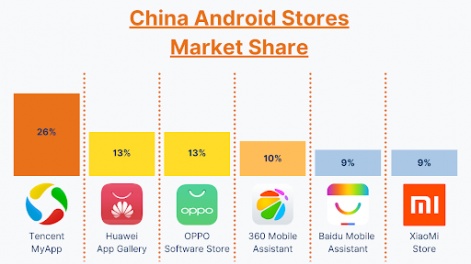
Getting licensed
To publish a game in China’s app stores, you need an ISBN and copyright license. Find out how to get licensed in our comprehensive guide to publishing in China.
The role of UA
User acquisition (UA) is not an easy task, because the presence of several stores has cluttered the continually growing landscape. For instance, a player using a Huawei phone will not check the Xiaomi store, and won't be able to see its corresponding ads.
Moreover, UA in China’s Android stores is not worth the time and effort because of revenue share. The return on investment (ROI) is rather low, as most stores take 50% of all revenue generated from games downloaded through their channels.
The solution? Running ads on alternative channels with the Yodo1 SDK - a groundbreaking solution that allows you to collect one hundred percent of the revenue generated from your games.
To learn more about effective UA strategies and retain your profit, read our article on how to capture the world’s largest mobile gaming audience.
Think organic
Given the low ROI of doing UA directly through the stores, getting found organically becomes the main way for players to see your games.
So, how can you use app store optimisation (ASO) to increase the exposure of your games? Start by adding keywords for players in relevant sections and shape your game description to the local audience’s interests. For screenshots and more in-depth insights, check our article on app store optimisation for China.
Get featured
Given that organic downloads are extremely important, the best way to showcase your game is by getting it to the featured list.
Getting featured on the biggest stores in China depends on the number of new users and total revenue generated by the game.
Having identified a game with high revenue potential, stores track the number of new users in chosen games for one to two weeks. Then, they determine which games they will feature on their homepage.
The store will feature a game in two phases:
- Phase 1: Homepage Feature for Sample Audience. The game will be featured on the store’s homepage and tested on a pool of users for one-to-two weeks while the store monitors its performance.
- Phase 2: Homepage Feature to All Users. If results surrounding the number of downloads, revenue, new users, and DAU (daily active users) from phase 1 are good, they feature the games to all users.
Performance in phase 2 will determine which spot a game gets.
Aim for the best spot
The best placement is an interstitial showcasing your game in a full-screen popup that appears right after a user opens the store.
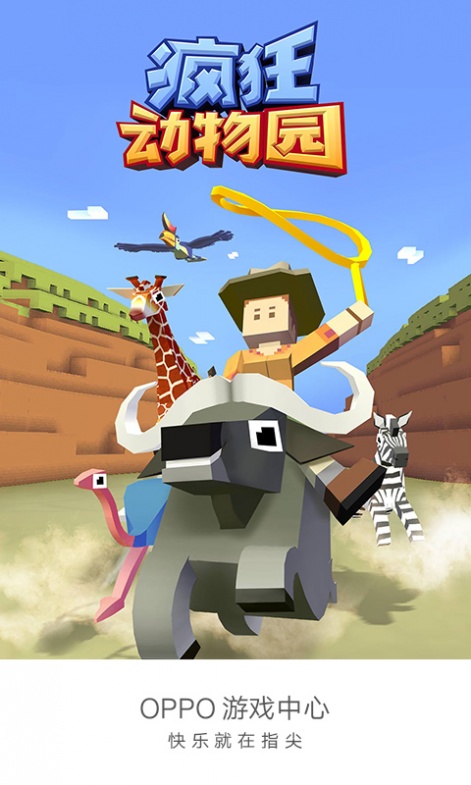
Next comes the homepage, with different spots that include banners and smaller features.
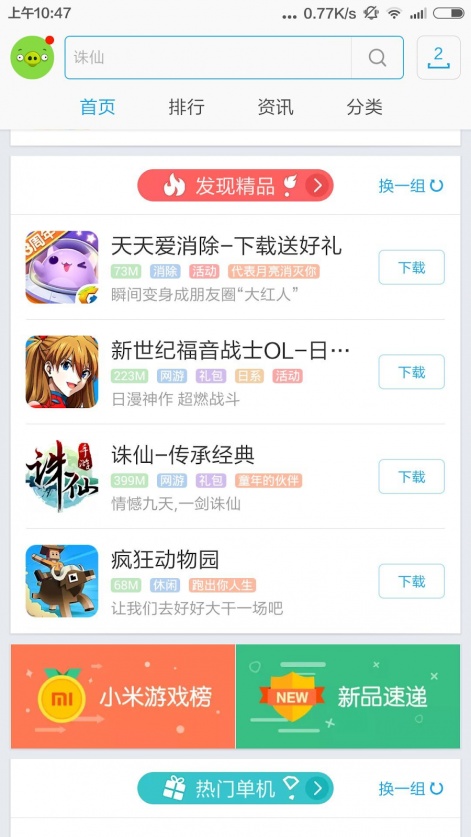
Games from similar genres are typically bunched together.
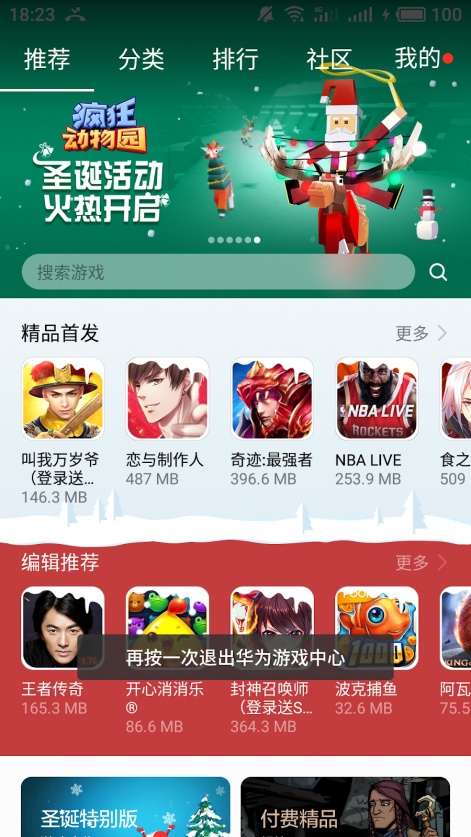
Just about all Chinese game app stores work in the same manner when it comes to featuring games: top spots are awarded to titles with the highest number of new users.
Yodo1 CEO Henry Fong shares our formula for getting game features in his free Business of Mobile Games Master Class. Take the course here.
Navigating Multiple SDK Requirements
Each store requires you to integrate its own SDKs (software development kits). For example, Huawei has two SDK types for in-app purchases - one for single and multiplayer games - and another SDK for in-app ads. The same goes for every other store.
Integrating each SDK for every store might seem cumbersome, but the ROI (Return on Investment) can be massive. Of the $40.85 billion revenue estimated to be generated in China this year, 70 per cent will come from Tier 3-5 cities, where 76 per cent of Chinese gamers reside. Given their lower disposable income compared to Tier 1-2 cities, this population vastly prefers to buy lower-end phones where Android, and its stores, are king.
With approximately 720 million gamers in the country, China is a market you do not want to miss.
What about H5 games?
Just about every major Chinese game app store hosts HTML5 or H5 games on its platform. This includes Tencent, as well as prominent handset manufacturer stores such as Huawei, OPPO, Vivo, and Xiaomi.
To reach the largest audience, distributing your games in both H5 and app format will be the best strategy.
The Yodo1 solution
Whether you want to publish your game and distribute it on China’s Android stores, or convert it to HTML5 format and reach a greater audience, Yodo1 is ready to help.
We’ll guide you through the best localisation and operation practices for each store, optimising your game to the remunerative Android audience. In addition, the Yodo1 SDK will enable you to track UA performance and leverage the best local ad networks to achieve optimal monetisation.
Our publishing team can also help partners transform their mobile games into HTML5 hits and distribute both versions on China’s biggest channels, from Android stores to WeChat, Douyin (China’s TikTok), and QQ.
Get in touch via bd@yodo1.com to reach a greater audience and increase your game revenue.
About Yodo1
Yodo1 is a game platform company that helps developers better market, manage, and monetize their games. Our AI-powered tools and global expertise in areas such as mobile advertising, community management, and digital IP licensing enable partners to increase playtime, revenue, and retention. Our vision is to open the world of gaming success to anyone with the talent to develop. To learn more, visit www.yodo1.com and follow us on LinkedIn.

